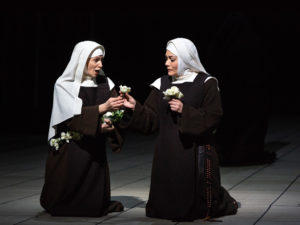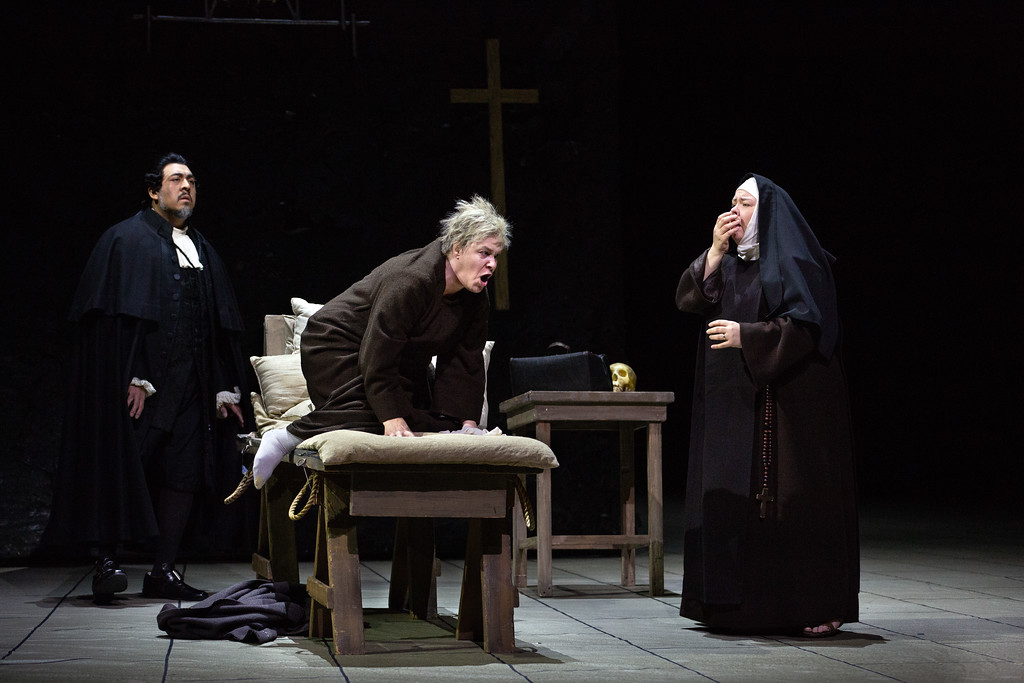
Metropolitan Opera 2022-23 Review: Dialogues des Carmélites
Ailyn Pérez, Sabine Devieilhe, Alice Coote Star in Glorious Revival of One of Met Opera’s Best Productions
By David Salazar(Credit: Marty Sohl / Metropolitan Opera)
John Dexter’s production of “Dialogues des Carmélites” remains one of the treasures of the Met stage.
Especially during a time when directors are bringing rather bland new productions to timeless classics, here’s a staging that is both traditional in its concept and imagery, but simultaneously modern in its economy of execution. Black and white form the basis of the entire staging and throughout most of its first half, those two colors dominate over all the proceedings. It’s only when the French revolution begins to creep into the foreground that we start seeing a blurring of the consistent color pale, an expansion of it that the narrative also fluctuates. On the surface, the presentation doesn’t really shift the story in any strange way.
And yet, if we analyze this narrative through color, it grows more complex and even rich. Most audiences would see black and white as rigid and unyielding. A world of structures and a lack of freedom. And it makes sense given the cultural context that led to the French revolution. The onslaught of color would suggest freedom of expression and opportunity. A world with more visual and emotional diversity. A world where one character can change from a sacristan to a soldier. And yet, the opera depicts this world as the true world of terror. It complicates the narrative in a very emotional way. Poulenc’s opera is set up to make us feel for the Carmélites and their plight with the French revolution’s chaos crushing them. And yet, their order is represented in darkness and shadows throughout most of the production.
The production’s opening image, the nuns all lying face down, arms out to mirror the Cross, is juxtaposed by the end with that same cross now completely empty. The initial impression this juxtaposition gives off is of loss and tragedy. And yet, the opening image was of subservience and sacrifice. Again, the visual storytelling complicates the emotional response. No other director is creating this kind of subtle and potent theater on the Met stage at this moment. This production first bowed in 1977.
What this production also does so well is that by stripping the stage bare, what we are left with is a hyper-focus on the interpreters.
Riveting & Powerful Women
In this revival, Alice Coote’s Madame de Croissy stood out as a dominant figure, her struggle setting the stage for the tragedy to come. In her initial scene with Blanche (Ailyn Pérez), Coote’s singing was cool and angular. The color of her voice matched the jagged iron gate that separated her from Blanche during that initial encounter. Juxtapose that with their reunion a few scenes later as the Prioress lies on her deathbed. When Mother Marie first mentions Blanche and that she has decided to take the name the Prioress suggested, Coote’s voice took on a more gentle complexion, and that fully evolved into a light and delicate line when Blanche herself arrived moments later. “Rellevez-vous” featured the most glorious singing from Coote the entire evening with tenderness in every note. Even the Fortes throughout this passage lacked the harder edge that was more present in the sections bookending this passage. When Javelinot entered to warn the Prioress of her impending doom, Coote’s voice lost all of its brightness, the mezzo’s sound harsh, her body flailing all over the bed as she fought to survive. It was a gripping experience and one of the most intense I have witnessed on the Met stage.

In the role of Madame Lidoine, Christine Goerke provided a fantastic vocal contrast to the rest of the cast. Her big moment comes in the second scene of Act two where she addressed the convent for the first time in an extended passage that stretches across her entire range. With her steely timbre cutting through the orchestra in a way no other singer on the night did, Goerke’s titanic sound rang through the theater as she imbued the moment with strength and confidence that she was trying to transmit to the rest of the Carmélites. Ascensions into her upper range did sound strained and intonation issues were the result, but the overall passage provided a sense of calm through strength and poise. In later scenes, Goerke sustained this sense of fortitude, her voice always beaming, even if her face suggested certain melancholy and sadness at the realization that the Carmélite order was being destroyed.
It was interesting seeing Jamie Barton’s evolution as Mother Marie. In the initial scenes, there was a coldness in her demeanor, a rigidity that seemed to match that of Coote’s attitude in her opening scene. Even in moments of emotional turmoil, such as the Prioress’ death, she retained that darker color and edge in her voice, at one point delivering a forceful forte toward another nun faltering in the face of death. In the ensuing scene, she scolded Blanche with similar aggression for leaving her post. But then there was a softening in latter scenes, matching the sheen of Goerke’s confident singing. Even in her final scene with Blanche, an encounter in which both characters are racked with fear over how to survive, Barton’s singing was full of compassion and warmth as she pleaded with Blanche. There were moments, especially in the first half where Barton’s middle and lower voice were overpowered by the orchestra, but by the second half, her sound was coming through cleanly.
A Story of Contrasts
The same could be said for Ailyn Pérez as Blanche, who struggled a bit in the initial scenes. There was a moment in the first scene where she wasn’t quite with the orchestra and her voice was difficult to hear throughout her exchange with her father. But as the night developed, her gorgeous soprano came through with greater clarity and focus. While she was quite potent in her first exchange with Sister Constance, particularly as she scolded her on “Posez ce fer ridicule et répondez-moi,” she really came into her own at the start of the second half during the scene with her brother.
It was a glorious moment of contrasts with tenor Piotr Buszewski frantically shifting around trying to get her attention, his tenor forceful and potent in the opening exchanges, but slowly growing thinner and more delicate as he seemingly lost all hope. Meanwhile, Pérez stood firm, her back to him, her soprano distant and cool in the opening scenes, especially on piano lines like “Hé quoi, la vie d’une Carmélite vous paraît elle si conform à la nature?” But then, as he left, she launched into an impassioned forte delivery of “Oh! Ne me quittez pas sur un adieu de fâche.” Eventually, her voice diminuendoed gloriously toward the final High A that concludes the passage. Her ensuing passage, “Il n’y a en moi à votre égard que douceur et tondresse,” had warmth and tenderness that were lacking in the opening of the scene, showcasing a more conciliatory exchange to close out this most heart-wrenching of exchanges and exposing the pain Blanche has been feeling this entire time.
The other standout moment for Pérez was the penultimate scene with Mother Marie where the soprano delivered some exhilaratingly horrifying fortissimo singing on “Voilà mon ragoût qui brûle!” her high range ringing clearly and forcefully all the way up to an intense high Cb. But she topped that moment later with another high B labeled fff on “Oui, ils m’ont frappée.” Pérez delivered on the dynamic marking, pushing her voice to its limit; this moment comes after pages of forte and fortissimo singing and a lot of singers arrive at those notes without much energy left. Pérez never faltered throughout this exchange, allowing the scene to build dynamic tension, the resulting outburst a truly visceral experience.
And that leaves Sabine Devieilhe’s Constance in a world of her own. Reveling in the bright and high writing of her part, Devieilhe was arguably the light of the entire performance. Where the rest of the singers had resonant and darker timbres, hers was light and gentle. While other interpreters of this production have played up the fear Constance feels throughout, Devieilhe’s Constance, even in her most trying moments, retained that brightness and warmth. Her opening scene with Pérez worked so well because of her beautifully playful singing contrasted with Pérez’s darker sound. In a later prayer duet together, the disparity of their vocal colors also enhanced their differing personalities. In her penultimate scene, when she notes a dream of Blanche returning, there was a mix of sadness and yet hope. Much like Goerke’s Lidoine never faltered in her strength, Devieilhe’s Constance seemingly never lost her hope.
This is an opera that centers on women, but it has plenty of men as well. Buszewski delivered an impassioned performance as Chevalier de la Force and was particularly potent in his scene with Pérez in Act two, though in the first scene and that one, he struggled a bit with his high notes which often sounded strained.
As his father, Laurent Naouri sang with ample sound and perfect diction, every word cutting through cleanly. There was some wobble in his voice but even then, you couldn’t miss a word. Tony Stevenson was also spot on as Chaplain, his delicate tenor a solid contrast to the darker female timbre. In the role of a Jailor, Jeongcheol Cha was unfortunately covered by the orchestra as he delivered the sentence.
Reserved But Beautiful
And that leaves conductor Bertrand de Billy who had a solid night overall. On one hand, there were moments of imbalance with the voices. From the orchestra section some singers simply couldn’t cut through the orchestra when in their middle or lower ranges; there were no problems in the upper range, however. Of course, the set is wide open and it’s possible that the massive stage swallows some of that sound; however, none of the singers from the revival from 2018-19 under Yannick Nézet-Séguin experienced these issues and they were mostly lighter voices across the board compared to this production.
That said, there was refinement in his conducting and way with the music. Rather than exploding into that opening passage, there was a level of restraint in the opening bars, allowing the “fate” motif to build and build throughout its initial repetitions. Instead of giving away all of the intensity from the start, his presentation was more methodical and even reserved, but ultimately more powerful over the course of two and a half hours. He never overstated any musical moments, instead creating a gentler and flowing feel throughout the evening that not only matched the setting of the convent.
That doesn’t mean he wasn’t ready to let loose with intensity when required. This was most clear during the Blanche-Chevalier scene in Act two with the main melody growing throughout with greater intensity upon each return, emphasizing the longing between these two siblings and the pain of separation. The fortes in this scene carried greater weight, emphasizing the emotional landscape that Blanche has left to be in the monastery.
And then, of course, there is the ending, one of opera’s greatest. The “Salve, Regina” was breathtaking in de Billy’s ability to sustain the line and slowly build it in intensity.
“Dialogues des Carmélites” is an opera that the Met always gets right. Its production is rightfully legendary and its music seems to elevate its performers. This particular revival is fascinating due to its casting – the way the voices of the central female singers match one another in color and temperament yet contrast in subtle and unique ways.


